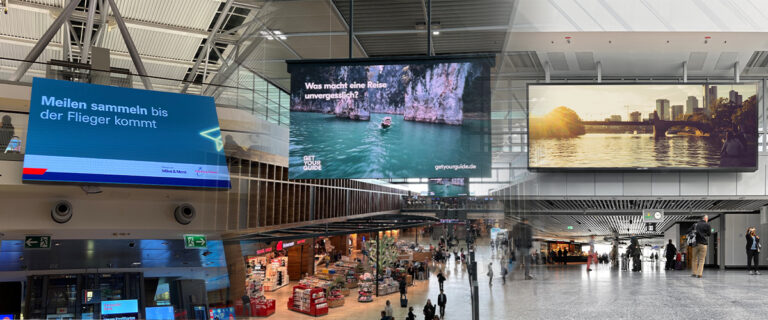Fire protection technology is crucial as airport operators look to digital transformation for new ways to boost operational efficiency and enhance the passenger experience. Integrating digital technology into sensitive areas, such as fire escape routes in airports, has posed significant approval and implementation challenges, making it difficult to maximize the potential of these high-traffic areas.
With the publication of the VdS 6024 leaflet in September 2023, a new nationwide fire protection procedure has been approved in Germany for the implementation of digital signage and screens in sensitive areas. For airport operators outside of Germany, the guidelines have been translated and are available for use internationally. Developed in collaboration with representatives from technology manufacturers, institutes, insurance companies, building authorities and inspection bodies, the VdS guidelines enable the realization of digital signage projects in areas previously deemed too risky, marking a significant leap forward in airport digitalization efforts.
How can airports unlock the potential of device-integrated fire protection technology using the new guidelines? And what have leading airports gained from integrating these cutting-edge solutions into their airport digital- and fire protection ecosystems?
VdS 6024 leaflet guidelines: enabling digital signage in airports, even in sensitive areas
A leading global authority in corporate security, specializing in fire protection, security, natural hazard prevention and cybersecurity, VdS is recognized for its highly valued seal of approval across various industry guidelines on a national, European and global level. Introduced on September 1, 2023, the VdS leaflet ‘Fire Protection for Electrical Devices in Sensitive Areas’, details a comprehensive verification process for organizations looking to manage fire safety without compromising on the digital modernization of airports and other public spaces.
The guidelines address a crucial gap in the deployment of digital signage, information points and LED walls within sensitive areas. Offering a detailed framework for assessing and mitigating the fire risks associated with electrical devices, the guidelines pave the way for their safe integration into critical areas of airport infrastructure.
The key objective of the guidelines is to establish standardized procedures for assessing electrical appliances’ suitability for use in sensitive areas, enhancing preventive fire protection measures. Its significance in airport operations cannot be overstated, as it enables the realization of digital signage projects in areas once considered high-risk due to fire safety concerns. By providing clear instructions, guidelines and regulations, it can assist airport operators and building authorities in navigating the complex landscape of fire safety and digital installation.
VdS 6024 sets forth comprehensive safety standards and technical requirements, emphasizing the importance of distinguishing between external and internal fire risks and proposing measures to mitigate these risks effectively. The guidelines promote a risk-based approach, where the fire load, potential ignition sources and the consequences of a fire due to faulty electrical devices are thoroughly evaluated. By doing so, it ensures that the deployment of digital signage and other electrical devices aligns with the overarching goal of minimizing fire hazards and protecting airport visitors and staff.
By incorporating device-integrated fire protection solutions, such as mini fire extinguishers and stringent material requirements, the guidelines not only enhance operational efficiency and safety but also open new communication and advertising opportunities in previously restricted zones.
With this, the publication of the VdS 6024 leaflet represents a leap forward for the evolving landscape of airport management, where safety and technological advancement go hand in hand. What technology is required to ensure airport operators can implement digital signage in more sensitive areas in accordance with these standards?
Bridging technology and safety: device-integrated fire protection
Fire protection regulations and risk assessments distinguish between “fire from outside” and “fire from inside”. While fire retardancy, non-combustible materials and fire prevention infrastructure mitigate the risks of the former, device-integrated fire protection is designed to tackle the latter, detecting and extinguishing a fire at the source, from within the device itself. Existing fire protection installations are designed to effectively extinguish fires quickly, but they can usually only do so once the fire has spread beyond the electrical device, increasing the risks to staff, visitors and infrastructure. The guidelines outline the properties required for qualification and approved use of extinguishing devices in electrical appliances. These include the use of an extinguishing agent, activation of the extinguishing system, permanent power supply cut-off and permanent extinguishing.
“The publication of the VdS 6024 leaflet represents a significant step. It creates clarity for everyone involved, from planning to official approval. This means the green light for digitalization and the use of media technology in public buildings – even for sensitive areas where this was previously not possible or only possible to a very limited extent,” explains Bodo Müller, CEO, Job Group.

The German firm is an innovation leader in fire protection and was actively involved in developing the new VdS guidelines. Devices fitted with E-Bulbs and automatic miniature fire extinguishers (AMFE) from Job were deployed in test setups that were used to develop a standardized test and inspection methodology. The E-Bulb mini extinguishing system is mounted directly onto the electronics platform to detect and fight a fire or overheating directly in the device, long before the fire can spread further. When the defined triggering temperature is reached, the extinguishing bulb bursts, releasing the special extinguishing agent. In addition, in the event of a fire, the power supply to the device is interrupted.
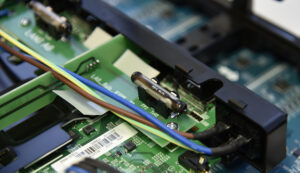

“Through the use of device-integrated fire protection in modern media technology, from LED walls and digital signage to information points and product presentation applications, we have the opportunity to deliver even more creative and flexible building projects,” says Walter Jünkering, fire protection expert for media technology.
Digital signage and LED walls, even in sensitive areas, can now be equipped with integrated self-extinguishing devices installed directly inside the device by manufacturers and certified system integrators following the new VdS guidelines. Innovative airport operators have wasted no time in tapping into the potential of integrated fire protection for digital signage.
Device-integrated fire protection in action: Frankfurt, Berlin and Hamburg airports
Due to the close collaboration between authorities, planners, manufacturers and integrators to develop the VdS guidelines, several projects have already been implemented which showcase how airports can integrate the technology to make safe digital devices even safer.
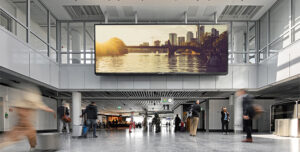
At Frankfurt Airport, Germany’s busiest hub, the safety of nearly 200,000 daily passengers and over 81,000 employees is paramount. Recognizing this, Samsung, in collaboration with Job, integrated E-Bulbs into its large-format LED media screens. Each of the 100 LED cabinets in Samsung’s 43m2 LED wall is equipped with this automatic extinguishing system. The successful implementation of the thermally activated bulbs showcases a unique advancement in device-integrated fire protection, setting a new standard for safety in high-traffic public and transit areas.
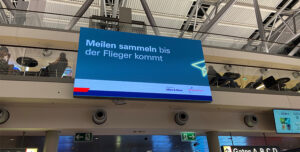
To enhance the passenger experience, Hamburg Airport has elevated its safety and infotainment standards by installing a state-of-the-art LED wall also equipped with Job’s E-Bulb technology. Ensuring the safety of over 11 million passengers a year required navigating the stringent safety measures necessary for approval and implementation. The device-integrated mini fire extinguishers, integrated within the LED wall behind the security checkpoint in the airport plaza, offer enhanced fire protection by activating at a specific temperature to extinguish any potential fires, without damaging the electronics. With its residue-free extinguishing liquid the innovative fire protection solution not only ensures passenger safety but also significantly reduces repair time and costs, marking a significant step forward in airport safety and efficiency.

Berlin Brandenburg managed to tackle the approval hurdle for implementing digital signage in public areas without making significant changes to its existing fire safety framework. This was achieved by integrating Job’s Automatic Miniature Fire Extinguishing Units (AMFE) into electronic information displays. Leveraging Job Thermo Bulbs, widely used in global sprinkler systems, for early fire detection, the AMFE units efficiently extinguish fires at their source. The inclusion of the S-AMFE system for this installation also ensures that any affected device is immediately cut off from power, preventing re-ignition. This innovative approach not only adheres to stringent fire protection standards but also secures the safety of passengers and visitors at BER Airport.
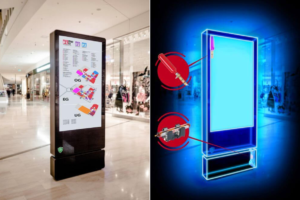
Embracing the new standard for digital devices in sensitive areas
With a validated process for approval and implementation, proven integrated fire protection technology and use cases already in the market, there are clear advantages with integrated fire protection for airport operators to consider in future digital signage projects.
Together the VdS guidelines and device-integrated fire protection technology can help accelerate digitalization projects, making installations even in escape and rescue routes possible, while increasing airport safety for passengers, staff and visitors, as well as for infrastructure. The clarity the guidelines provide for airport operators, planners, manufacturers and building authorities offers greater efficiency and simplifies the management of these previously highly complex projects. It also enables comparability of different providers of certified integrated fire protection solutions that meet the requirements covered by the guidelines.
Once the digital signage is in place, airport operators can reap the benefits of increased devices to communicate relevant messages to passengers in the right place and at the right time, as well as provide news and entertainment for travelers and additional opportunities for commercial advertisers. All this while ensuring the continued safety of millions of passengers, staff and visitors who pass through their airports every year.
In related news, all flights were recently suspended at London Luton Airport after a massive blaze caused the terminal parking garage to partially collapse. Click here to read the full story.

